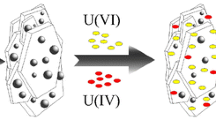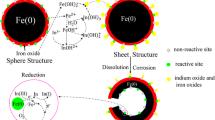Abstract
79Se is one of the important radionuclides in the safety evaluation of high-level radioactive waste repository due to its long half-life and highly fissionable radioactivity. Nanoscale zero valent iron-nickel bimetallic composite (Fe0/Ni0) was fabricated by liquid phase reduction method for Se(IV) adsorption from aqueous solution. The effects of pH, solid–liquid ratio, time, temperature, initial concentration of Se(IV) on the adsorption of Se(IV) by Fe0/Ni0 were investigated. Fe0/Ni0 was characterized by SEM, XPS, XRD, FT-IR, BET and Zeta potential, and the mechanism of removing Se(IV) was analyzed. The results showed that Fe0/Ni0 had a good removal effect on Se(IV). When pH was 3.5, the solid–liquid ratio was 0.3 g L−1, the reaction time was 40 min, the maximum adsorption capacity of Se(IV) by Fe0/Ni0 could reach 180 mg g−1. The research results can provide a theoretical basis for the treatment of wastewater containing Se(IV).






Similar content being viewed by others
References
Larimi Y, Mallah M, Moosavian M, Safdari J (2013) Fabrication of a magmolecule using nanoparticle and evaluation of its adsorption capacity for selenium ions from nuclear wastewater. J Radioanal Nucl Chem 298:1511–1518
Ippolito J, Scheckel K, Barbarick K (2009) Selenium adsorption to aluminum-based water treatment residuals. J Colloid Interface Sci 338:48–55
Li H, Zhou M, Guan E, Li Z (2021) Preparation of wheat bran-titanium dioxide (TiO2) composite and its application for selenium adsorption. J Cereal Sci 99:103230
Li D, Yan W, Guo X, Tian Q, Xu Z, Zhu L (2020) Removal of selenium from caustic solution by adsorption with Ca-Al layered double hydroxides. Hydrometallurgy 191:105231
Ma Z, Shan C, Liang J, Tong M (2018) Efficient adsorption of Selenium(IV) from water by hematite modified magnetic nanoparticles. Chemosphere 193:134–141
Wang Y, Gu Z, Yang J, Liao J, Yang Y, Liu N, Tang J (2014) Amidoxime-grafted multiwalled carbon nanotubes by plasma techniques for efficient removal of uranium(VI). Appl Surf Sci 320:10–20
Bakather O, Kayvani F, Ihsanullah K, Nasser M, Atieh M (2017) Enhanced adsorption of selenium ions from aqueous solution using iron oxide impregnated carbon nanotubes. Bioinorg Chem Appl 2017:4323619
Jordan N, Franzen C, Lützenkirchen J, Foerstendorf H, Hering D, Weiss S, Heim K, Brendler V (2018) Adsorption of selenium(vi) onto nano transition alumina. Environ Sci: Nano 5:1661–1669
Zhifen W, Hui Z, Rongjing T, Qifeng J, Rong H, Peng R, Boping L, Mingbiao L (2022) An investigation of Re(VII) and Se(IV) adsorption by Tamusu clay: effect of time, pH, ionic strength, temperature and organic acids. J Radioanal Nucl Chem 331:3461–3473
Ervanne H, Hakanen M, Lehto J (2015) Selenium sorption on clays in synthetic groundwaters representing crystalline bedrock conditions. J Radioanal Nucl Chem 307:1365–1373
Wang S, Xiao K, Mo Y, Yang B, Vincent T, Faur C, Guibal E (2020) Selenium(VI) and copper(II) adsorption using polyethyleneimine-based resins: Effect of glutaraldehyde crosslinking and storage condition. J Hazard Mater 386:121637
Wei J, Shen B, Ye G, Wen X, Song Y, Wang J, Meng X (2021) Selenium and arsenic removal from water using amine sorbent, competitive adsorption and regeneration. Environ Pollut 274:115866
Rodríguez-Martínez C, González-Acevedo Z, Olguín M, Frías-Palos H (2015) Adsorption and desorption of selenium by two non-living biomasses of aquatic weeds at dynamic conditions. Clean Technol Envir 18:33–44
Chen M, An M (2012) Selenium adsorption and speciation with Mg-FeCO3 layered double hydroxides loaded cellulose fibre. Talanta 95:31–35
Jan B, Tsai S, Li Y (2014) Determination of sorption and diffusion parameters of Se(IV) on crushed granite. J Radioanal Nucl Chem 301:365–371
Jordan N, Ritter A, Foerstendorf H, Scheinost A, Weiß S, Heim K, Grenzer J, Mücklich A, Reuther H (2013) Adsorption mechanism of selenium(VI) onto maghemite. Geochim Cosmochim Acta 103:63–75
Ling L, Pan B, Zhang W (2015) Removal of selenium from water with nanoscale zero-valent iron: mechanisms of intraparticle reduction of Se(IV). Water Res 71:274–281
Qiu Z, Tian Q, Zhang T, Yang D, Qiu F (2020) Fabrication of dynamic zero-valent iron/MnO2 nanowire membrane for efficient and recyclable selenium separation. Sep Purif Technol 230:115847
Abdolmohammad-Zadeh H, Jouyban A, Amini R, Sadeghi G (2013) Nickel-aluminum layered double hydroxide as a nano-sorbent for the solid phase extraction of selenium, and its determination by continuous flow HG-AAS. Microchim Acta 180:619–626
Zhu F, Liu T, Zhang Z, Liang W (2021) Remediation of hexavalent chromium in column by green synthesized nanoscale zero-valent iron/nickel: factors, migration model and numerical simulation. Ecotoxicol Environ Saf 207:111572
Danish M, Gu X, Lu S, Brusseau M, Ahmad A, Naqvi M, Farooq U, Zaman W, Fu X, Miao Z (2017) An efficient catalytic degradation of trichloroethene in a percarbonate system catalyzed by ultra-fine heterogeneous zeolite supported zero valent iron-nickel bimetallic composite. Appl Catal A Gen 531:177–186
Xia X, Hua Y, Huang X, Ling L, Zhang W (2017) Removal of arsenic and selenium with nanoscale zero-valent iron (nZVI). Acta Chim Sinica 75:594–601
Adio S, Omar M, Asif M, Saleh T (2017) Arsenic and selenium removal from water using biosynthesized nanoscale zero-valent iron: a factorial design analysis. Process Saf Environ 107:518–527
Chen Y, Zhang J, Xu H (2022) Exploration of the degradation mechanism of ciprofloxacin in water by nano zero-valent iron combined with activated carbon and nickel. J Mol Liq 345:118212
Tan X, Fang M, Chen C, Yu S, Wang X (2008) Counterion effects of nickel and sodium dodecylbenzene sulfonate adsorption to multiwalled carbon nanotubes in aqueous solution. Carbon 46:1741–1750
Cui W, Li P, Wang Z, Zheng S, Zhang Y (2018) Adsorption study of selenium ions from aqueous solutions using MgO nanosheets synthesized by ultrasonic method. J Hazard Mater 341:268–276
Wu P, Wang Y, Hu X, Yuan D, Liu Y, Liu Z (2019) Synthesis of magnetic graphene oxide nanoribbons composite for the removal of Th(IV) from aqueous solutions. J Radioanal Nucl Chem 319:1111–1118
Wu P, Wang Y, Li Y, Hu X, Xiu T, Yuan D, Liu Y, Wu Z, Liu Z (2019) Adsorption of Th(IV) from aqueous solution by the graphene oxide nanoribbons/chitosan composite material. J Radioanal Nucl Chem 322:553–559
Hu X, Wang Y, Yang J, Li Y, Wu P, Zhang H, Yuan D, Liu Y, Wu Z, Liu Z (2020) Synthesis of graphene oxide nanoribbons/chitosan composite membranes for the removal of uranium from aqueous solutions. Front Chem Sci Eng 14(6):1029–1038
Yu S, Yin L, Pang H, Wu Y, Wang X, Zhang P, Hu B, Chen Z, Wang X (2018) Constructing sphere-like cobalt-molybdenum-nickel ternary hydroxide and calcined ternary oxide nanocomposites for efficient removal of U(VI) from aqueous solutions. Chem Eng J 352:360–370
Acknowledgements
This work was financially supported by the National Natural Science Foundation of China (11465002, 11765002, 41761090), Open Project Foundation of Stake key Laboratory of Nuclear Resources and Environment (East China University of Technology) (2022NRE30), and the Scientific and Technical Project of the Educational Department in Jiangxi Province (GJJ200715).
Author information
Authors and Affiliations
Corresponding authors
Ethics declarations
Conflict of interest
The authors declare that there is no conflict of interest regarding the publication of this article.
Additional information
Publisher's Note
Springer Nature remains neutral with regard to jurisdictional claims in published maps and institutional affiliations.
Rights and permissions
Springer Nature or its licensor (e.g. a society or other partner) holds exclusive rights to this article under a publishing agreement with the author(s) or other rightsholder(s); author self-archiving of the accepted manuscript version of this article is solely governed by the terms of such publishing agreement and applicable law.
About this article
Cite this article
Du, Y., Fu, X., Zhou, Q. et al. Preparation of zero-valent iron-nickle bimetallic composite for Se(IV) adsorption from aqueous solution. J Radioanal Nucl Chem 332, 785–796 (2023). https://doi.org/10.1007/s10967-023-08789-5
Received:
Accepted:
Published:
Issue Date:
DOI: https://doi.org/10.1007/s10967-023-08789-5




